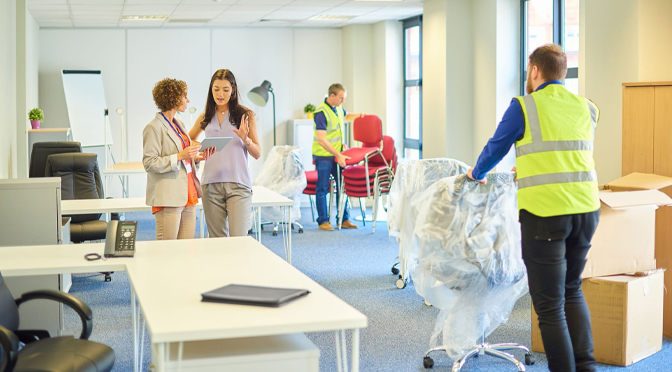Relocating a business is a significant undertaking that requires careful planning, especially regarding packing.
A well-organised move can minimise downtime, ensuring your business operations continue smoothly.
This blog provides efficient packing strategies for commercial moves, focusing on tips to reduce disruptions during the relocation process.
The Importance of A Well-Organised Packing Plan
The key to a successful commercial move is a well-organised packing plan. Without a strategic approach, the move can lead to prolonged downtime, affecting productivity and customer satisfaction.
To avoid these issues, start by creating a detailed plan that includes:
1. Labelling Systems
A clear and consistent labelling system is essential for efficient packing.
Each box should be labelled with its contents, the department it belongs to, and its destination in the new location.
Using colour-coded labels or digital tracking tools can help movers identify where each box should go, speeding up unpacking and minimising downtime.
2. Creating a Timeline
Developing a timeline is critical to staying organised throughout the move.
Set specific deadlines for each stage of the packing process, from inventory assessment to the final move day.
Assign these tasks to specific teams or individuals, ensuring accountability and adherence to the schedule.
A clear timeline also helps coordinate with your commercial removal company, ensuring everyone is aligned on the moving day logistics.
Key Packing Strategies To Minimise Downtime
Once you have a plan, it’s time to focus on packing strategies to streamline the process and reduce downtime during your business relocation.
Here are some essential tips:
1. Delegate and Assign Tasks
Effective delegation is crucial in a business move. Assign specific packing tasks to each department to ensure that all team members are involved in the process.
For example, IT staff should handle the packing of technical equipment, while administrative staff can focus on files and paperwork.
This strategy speeds up the packing process and ensures that items are handled by those who know them best, reducing the risk of damage or misplacement.
2. Use Professional Packing Materials
Investing in high-quality packing materials is essential for protecting your assets during a commercial move.
Sturdy boxes, bubble wrap, packing peanuts, and other cushioning materials safeguard fragile and valuable items. Specialised containers may be required for sensitive equipment like computers, servers, and other electronics.
High-quality packing materials might be more expensive, but they significantly reduce the risk of damage, ultimately saving you money in the long run.
3. Hire Movers Specialising In Commercial Moves
Hiring a business mover experienced in commercial relocation can significantly reduce downtime.
Professional movers understand the complexities of business moves, including handling delicate equipment, organising packing efficiently, and coordinating logistics to ensure a seamless transition.
A business relocation service also offers insurance coverage, providing peace of mind in case of damage or loss during the move.
Managing IT Equipment and Sensitive Electronics
One of the most challenging aspects of a commercial move is safely handling & moving IT equipment and other sensitive electronics. Downtime can be drastically reduced if you take the following steps:
1. Back-Up All Data
Before moving any IT equipment, ensure that all data is backed up securely. This step is crucial to avoid data loss in case of any damage during the move.
Create a cloud backup or store essential information using an external hard drive.
2. Pack IT Equipment Properly
Disassemble all IT equipment carefully and label each component to make reassembly easier.
Antistatic bubble wrap and foam inserts protect servers, computers, and other sensitive devices from shocks and vibrations during transit.
Transport these items in their original packaging to ensure maximum protection.
3. Set Up IT Infrastructure First
At the new location, prioritise setting up your IT infrastructure to get your business back online as quickly as possible.
Work with your IT team or hire a specialist to ensure all systems run smoothly before resuming operations.
4. Safeguarding Fragile Items
Protecting fragile items during a business move is vital to prevent loss or damage. Here are some tips to ensure that delicate items arrive at the new location safely:
- Use Extra Cushioning: Wrap fragile items in multiple layers of bubble wrap and pack them in boxes with cushioning materials like foam peanuts or air pillows.
- Label as Fragile: Mark all boxes containing delicate items as “Fragile” to ensure they are handled carefully.
Pack Strategically: Place heavier items at the bottom of the boxes and lighter, fragile items on top to reduce the risk of breakage.
5. Unpacking In Stages
To minimise downtime, consider unpacking in stages. First, focus on setting up the most critical areas of your business, such as the IT department, customer service desks, and any essential equipment required for daily operations. This approach allows your team to resume work as quickly as possible while the rest of the office is being unpacked.
Unpacking in stages also helps you maintain order and reduce chaos in the new office, making the transition smoother for everyone involved.
Additional Tips For A Seamless Transition-
- Communicate With Your Team: Keep all employees informed about the moving schedule and their roles. Clear communication prevents confusion and ensures everyone is on the same page.
- Update Business Contacts: To prevent disruption in business relations, notify your clients, vendors, and service providers about the move well in advance.
- Plan for Contingencies: Prepare for potential delays or issues that could arise during the move and have a contingency plan to handle these situations efficiently.
Wrap Up
Efficient packing strategies are crucial for minimising downtime during a commercial move.
Creating a well-organised packing plan, using suitable materials, delegating tasks, and prioritising IT setup can ensure a smooth transition for your business.
Hiring professional movers and unpacking in stages can reduce disruptions, allowing you to get back to business quickly and efficiently.
For more seamless commercial removals and relocation services, contact a G Line Movers who will guide you through every step of the process and ensure your move is as smooth as possible.
 CALL:
CALL: 



